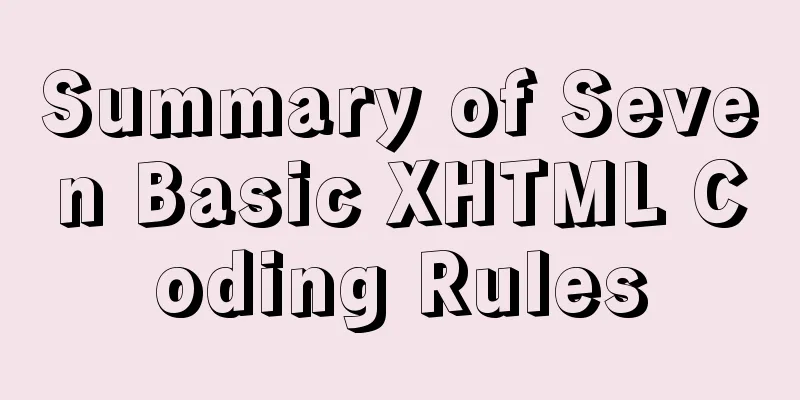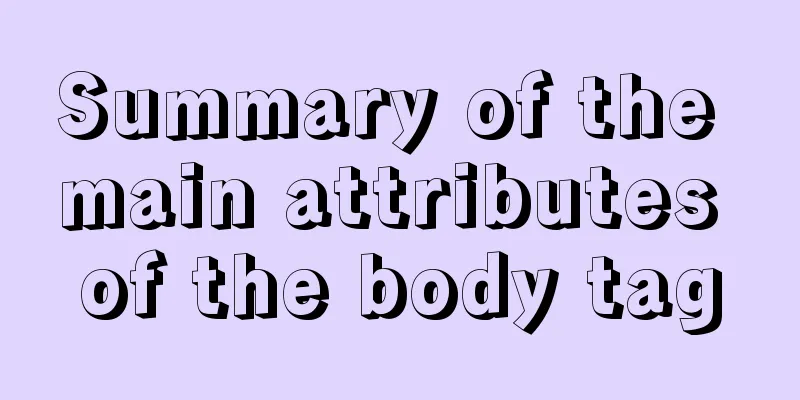Summary of Seven Basic XHTML Coding Rules

|
1. All tags must have a corresponding end tag Previously in HTML, you could open tags such as <p> and <li> without necessarily writing the corresponding </p> and </li> to close them. But this is not legal in XHTML. XHTML requires a strict structure and all tags must be closed. If it is a single unpaired tag, add a "/" at the end of the tag to close it. For example: <br /><img height="80" alt="Web Designer" src="../images/logo_w3cn_200×80.gif" width="200" /> 2. The names of all elements and attributes of tags must be lowercase. <br />Unlike HTML, XHTML is case sensitive. <title> and <TITLE> are different tags. XHTML requires that all tag and attribute names must be lowercase. For example: <BODY> must be written as <body>. Mixing uppercase and lowercase letters is also not recognized. Usually, the attribute name "onMouseOver" automatically generated by Dreamweaver must also be changed to "onmouseover". 3. All XHTML tags must be nested properly Also, because XHTML requires a strict structure, all nesting must be in order. Previously, we wrote the code like this: <p><b></p>/b> must be modified to: <p><b></b>/p> That is to say, the nesting layers must be strictly symmetrical. 4. All attributes must be enclosed in quotation marks "" In HTML, you don't have to quote attribute values, but in XHTML, they must be quoted. For example: <height=80> must be changed to: <height="80"> In special cases, you need to use double quotes in the attribute value. You can use ", and single quotes can be used ', for example: <alt="say'hello'"> 5. Encode all < and & special symbols Any less-than sign (<) that is not part of a tag must be encoded as & lt ; Any greater-than sign (>) that is not part of a tag must be encoded as > Any ampersand (&) that is not part of an entity must be encoded as & Note: There is no space between the above characters. 6. Assign a value to all attributes XHTML stipulates that all attributes must have a value, and those without a value must repeat themselves. For example: <td nowrap> <input type="checkbox" name="shirt" value="medium" checked> Must be modified to: <td nowrap="nowrap"> <input type="checkbox" name="shirt" value="medium" checked="checked"> 7. Don’t use “–” in comments "–" can only occur at the beginning and end of an XHTML comment, i.e. they are no longer valid within the content. For example, the following code is invalid: <!–Comment here———–Comment here–> Replace the internal dashes with equal signs or spaces. <!–Comment here============Comment here–> Some of the above specifications may seem strange, but all of these are to make our code have a unified and unique standard to facilitate future data reuse. |
<<: Solution to the problem that mixin does not work in scss (browser cannot compile it)
>>: I have sorted out some domestic design websites that I think are good.
Recommend
Mysql vertical table conversion to horizontal table method and optimization tutorial
1. Vertical table and horizontal table Vertical t...
Example of using js to natively implement year carousel selection effect
Preface Use js to achieve a year rotation selecti...
Enable OCSP to improve https certificate verification efficiency and solve the problem of slow access to Let's Encrypt SSL certificates
In the past few days, the website has been access...
The docker-maven-plugin plugin cannot pull the corresponding jar package
When using the docker-maven-plugin plug-in, Maven...
In-depth study of MySQL multi-version concurrency control MVCC
MVCC MVCC (Multi-Version Concurrency Control) is ...
How to update, package, and upload Docker containers to Alibaba Cloud
This time, we will try to package the running con...
Example analysis of mysql non-primary key self-increment usage
This article uses an example to illustrate the us...
Docker installation and configuration steps for RabbitMQ
Table of contents Single-machine deployment Onlin...
Introducing icons by implementing custom components based on Vue
Preface In project development, there are many wa...
How to use JS code compiler Monaco
Preface My needs are syntax highlighting, functio...
How to implement page jump in Vue project
Table of contents 1. Create a vue-cli default pro...
Detailed explanation of the principles and usage of MySQL data types and field attributes
This article describes the MySQL data types and f...
Some references about colors in HTML
In HTML, colors are represented in two ways. One i...
Three common style selectors in html css
1: Tag selector The tag selector is used for all ...
Implementing carousel effects with JavaScript
This article shares the specific code for JavaScr...









